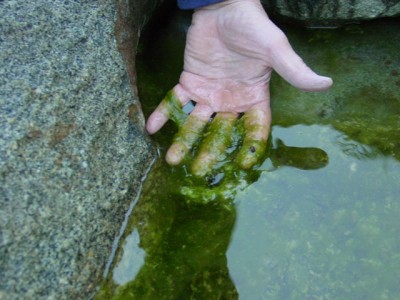How-To

I’ve got algae in my pond. Now what?
There are three types of algae that can grow in your pond:
Planktonic Algae: This is a free swimming algae that grows in warm water and turns the water a pea-soup green color so you can’t see the bottom or the fish.
Filamentous Algae: Also known as Hair or String Algae or “mossy” algae. It is fixed in place and grows like coral, one body on top of the other until it creates large long strings. This type of algae likes moving water and will grow in the areas that have the most current.
Short 1/4” Algae: This algae grows on the sides of the pond and on any wet surface including the rocks. This algae is actually beneficial for the pond. It helps moderate the PH of the water, it provides oxygen for the fish and they eat it. It also competes for the same food that the other types of algae want.
 Understanding Algae: Algae growing in the oceans of the world produce more oxygen than all the trees on all the continents and are also eaten by fish so it is beneficial but unsightly in our ponds. Algae are like dandelions in your lawn. Given light and fertilizer the algae will grow until a more beneficial organism competes for the light and the fertilizer. To combat algae in our ponds we remove the light and/or the fertilizer.
Understanding Algae: Algae growing in the oceans of the world produce more oxygen than all the trees on all the continents and are also eaten by fish so it is beneficial but unsightly in our ponds. Algae are like dandelions in your lawn. Given light and fertilizer the algae will grow until a more beneficial organism competes for the light and the fertilizer. To combat algae in our ponds we remove the light and/or the fertilizer.
How do I calculate my pond’s gallonage?
Calculating the gallonage of your pond is easy. Simply multiply the average length x the average width x the average depth x 7.5 and the result will give you the number of gallons. Easy! And now you know.
Please note that we’ve updated our newsletter format. You may navigate through this newsletter by clicking on the page numbers below.
